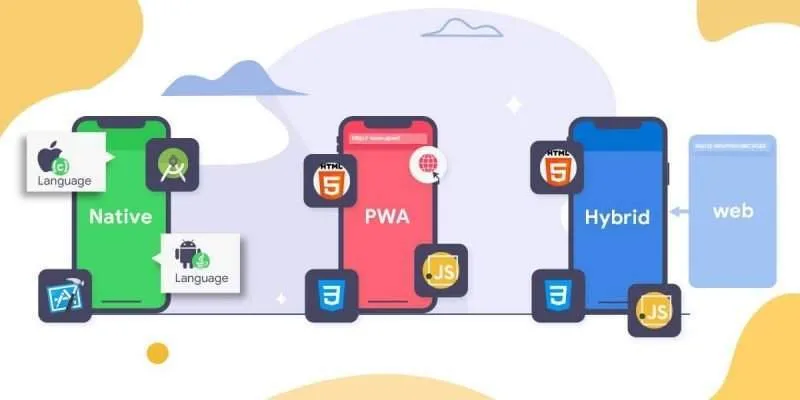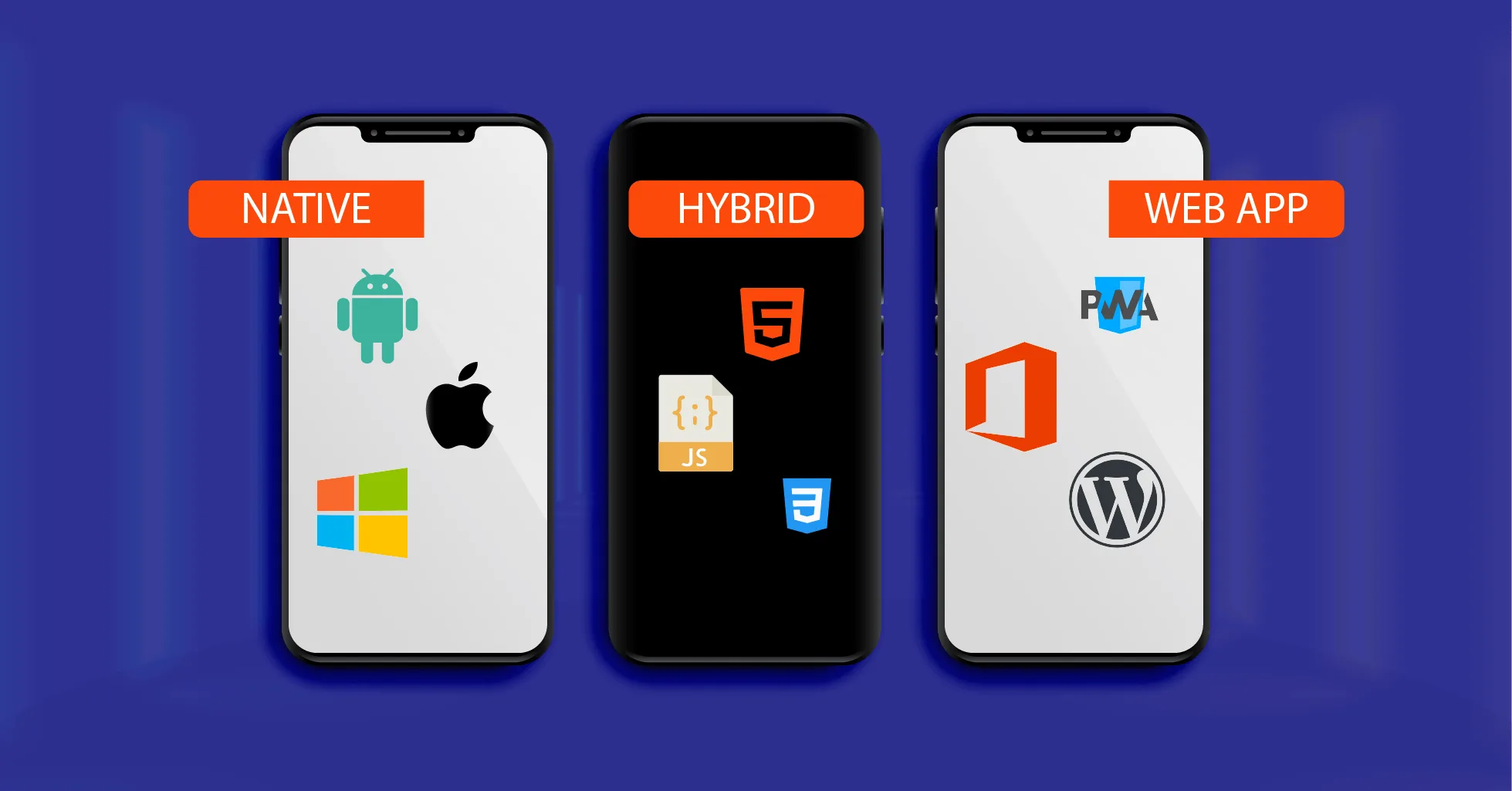This article explores the differences, advantages, and disadvantages of native apps, hybrid apps, and web apps.
These days having a dedicated mobile business app is rapidly transitioning from being a novelty to an absolute requirement. According to a recent survey, mobile internet has grown staggering 504% in daily media consumption since 2011, while US consumers spent 90% of their mobile time browsing the phone’s apps.
Neglecting this lucrative piece of the market may as well be considered a crippling disadvantage.
However, knowing this fact doesn’t make life any easier when it comes to actual app development. These days, most mobile apps can be divided into three major groups – native, hybrid, and web-based – all of which offer some unique perks and a couple of distinct drawbacks.
The app’s ultimate success may largely be determined by this initial choice you make at the start of the development process. Let’s take a look then what are the available options.
The available platforms
But, before we go to the specific, we first need to take a glance at the available ecosystems. First and foremost, when we say “mobile app,” we are primarily referring to smartphones, tablets, and phablets (wearables are excluded from this conversation).
The present-day mobile market has primarily boiled down to two main competitors- Android by Google and iOS by Apple. Although your overall goal should be to cover both these options, you must know that during 2020, Android managed to corner as much as 87% of the global mobile market. If you are pursuing worldwide fame, developing an app for Google’s mobile ecosystem should be your absolute priority.
Now that we’ve addressed this critical issue, let us go through the main differences between native and hybrid mobile apps.
Hybrid mobile apps
As the name suggests, hybrid mobile apps represent a middle ground between native and mobile apps, sharing many built-in advantages of both these groups. This simple fact significantly impacted the growing popularity of hybrid app development services over the last couple of years. The “hybrid” element of this model comes from the fact that the apps can be installed on the device and run via any web browser.
Advantages of hybrid apps
- Platform-agnostic availability – We have already mentioned the importance of covering both major mobile OS players. Since they are using a shared web codebase, hybrid apps can be used on both iOS and Android devices.
- Affordable development process – Since they feature a straightforward architecture, hybrid apps are easy and inexpensive to develop while still benefiting from being featured on native app stores.
- Seamless device access – Unlike web apps ultimately sandboxed to the web environment, hybrid apps have access to essential internal features like push notifications and GPS tracking.
Disadvantages of hybrid apps
- Steep learning curve – While apps are developed exclusively with streamlined technologies like CSS and JavaScript, hybrid apps integrate various other frameworks like Cordova, making their development process a bit harder.
- Inconsistent user experience – Since they are partially dependent on external resources, hybrid apps’ performance quality may be impacted by the internet speed.
Native mobile apps
Essentially, native apps are what most of us think when we are talking about mobile applications. They are downloaded from the native app store and feature a big, colorful icon on your device’s home screen. They are developed in the coding language of that native OS and (e.g., Objective C for iOS devices) and offer the most consistent performance.
Advantages of native apps
- Speed and reliability – Native apps are loaded and run by the native OS without relying on external resources. This makes them, by far, the fastest and most reliable option on the market.
- Full access to device resources – Since they are fully integrated into the native OS, native mobile apps can also freely interact with all system features like user contact list, camera, microphone, etc.
- Superior user interface – Since they are designed to meet all the standards of the native OS, native mobile apps usually feature better optimized and easier to navigate UI.
- App store visibility – Unlike the two other alternatives we will cover in this article, native apps have much better visibility in the native app stores and a better chance of being organically discovered by new users.
Disadvantages of native apps
- Substantial upfront costs – Even if you are developing an app for only one OS, native apps feature much higher upfront costs than the alternatives. Tackling both relevant ecosystems only doubles the costs.
- Requires good OS knowledge and experience – Native apps must be compatible with the previous versions of the native OS and their unique resources to use all the advantages of this concept. This requires a developer team with a lot of knowledge and experience in the branch.
Speaking in the simplest of terms, web apps can be best described as websites that look and behave like mobile apps. Although this concept may seem very limiting, some recent examples of progressive web apps (can run in the background, do support push notifications, etc.) have shown just how far this concept evolved over the last couple of years. Unlike the other two varieties we have covered in this article, web apps are built entirely with internet technologies (HTML, CSS, and JavaScript).
Advantages of web apps
- Comparative simplicity – Since they are, essentially, built as app-like websites, mobile apps are straightforward, affordable, and fast to develop with an excellent cross-platform appeal.
- Ease of maintenance – Being able to work with the same codebase, developers can easily maintain the app regardless of the native OS. Accordingly, end-users get the latest version of the app as soon as they open it without performing the update through the app store manually.
- No marketplace approval – Web apps are not featured on native app stores meaning they don’t need to go through the very demanding and often tiresome approval process.
Disadvantages of web apps
Compromised performance – All of the disadvantages of web apps can be summed up to one point. Since they operate in what can be best described as a browser environment, web apps are severely constricted by this sandbox playground. They don’t have access to a complete list of device functions. They don’t get to use all the intuitive navigation options of the native OS. They are entirely reliant on external resources like internet speed.

The Debate
The debate between Native Apps, Hybrid Apps and Web Apps continues to rage, with no absolute winner being found. However, your choice will largely depend upon a number of competing factors, such as your time frame and your budget. While some experts debate the importance of using hybrid apps versus native ones, others believe that by using a hybrid app you will be able to take advantage of new advances in the mobile technology. For example, the iPhone has a native application called Maps, while Google currently owns the Android mobile operating system and has many apps on its mobile platform which runs on top of Android.
Another big difference between native apps and hybrid ones is the level of user control, which they provide. While users do not have full control over how the information in a native app is displayed or accessed, they can do certain things with a hybrid app. However, mobile app development differs from traditional website development in a number of ways. Firstly, mobile app developers cannot easily create a single web page and place it on many devices. They must create a number of different native apps and integrate them together in order to create a cohesive experience on the phone.
In addition to web apps being native applications, they can also be developed using JavaScript. A good example of a javascript-developed app would be an online store that allows customers to make purchases using their credit card. Many people use these types of apps on the android, which is an operating system that is based on Java. There are some examples of JavaScript code, which can be integrated into a web app, for example a shopping cart, which may be developed using a set of Java script and web services such as Express or jQuery.
In conclusion
This short overview should give you some general look into the state of matters of the present-day mobile app market. The biggest thing to take away from this article is that mobile app development doesn’t know the idea of one-size-fits-all solutions. Be sure to take an objective look then at where your business sits at the moment and what kind of app you would get the most advantage of. Making a wrong choice will severely undermine all of your subsequent efforts from the get-go.







